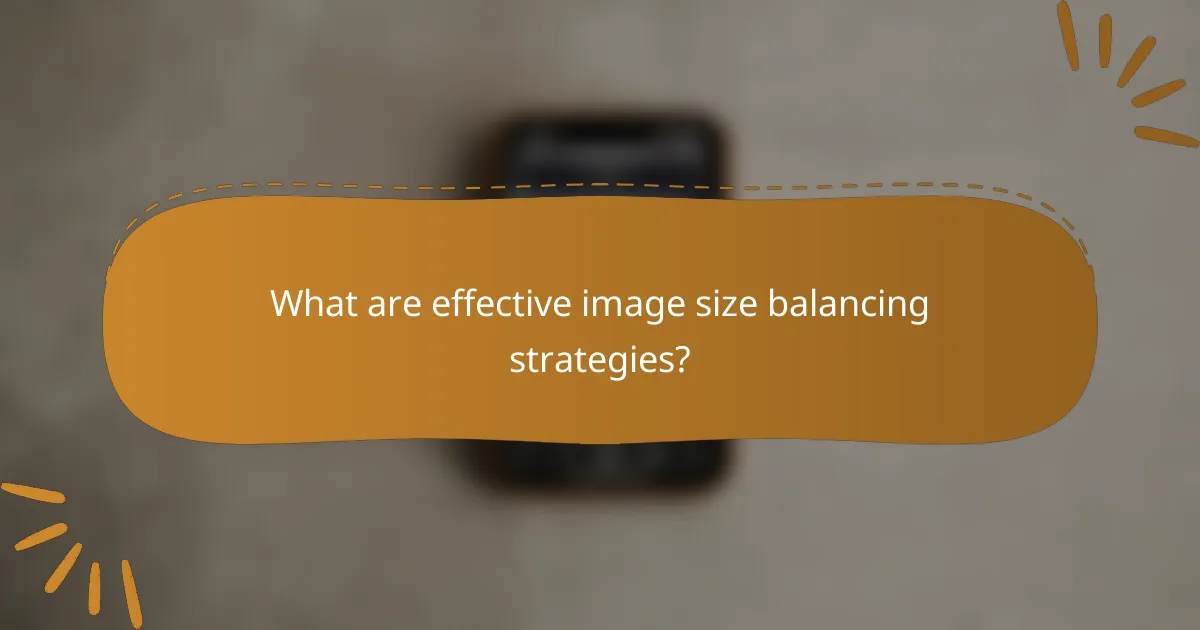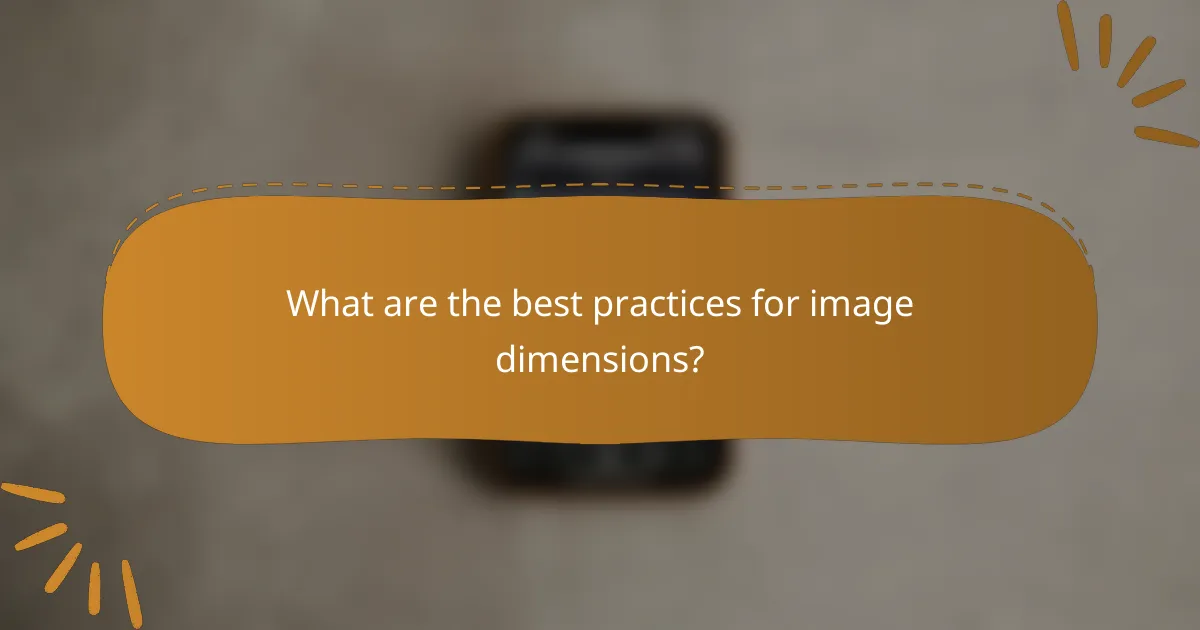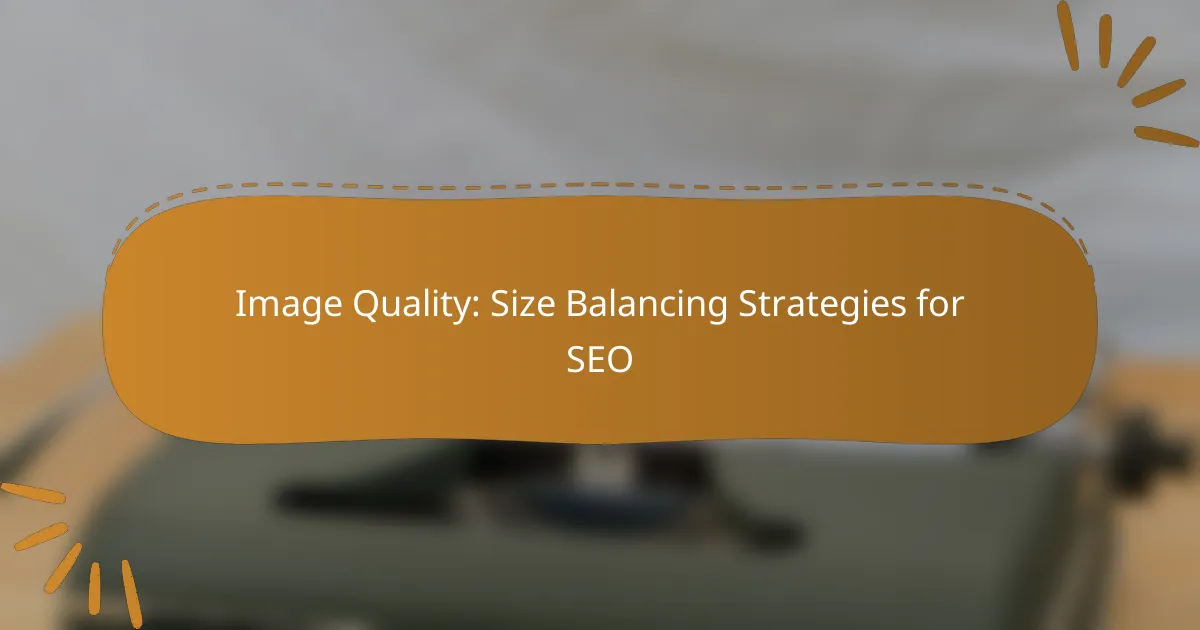Image size plays a crucial role in SEO, as it directly impacts load speed, user experience, and search engine rankings. By implementing effective size balancing strategies, such as compression and format selection, websites can enhance performance while preserving visual quality, leading to improved engagement and visibility in search results.

How can image size impact SEO performance?
Image size significantly affects SEO performance by influencing load speed, user experience, and search engine rankings. Optimizing images for size can lead to faster page loads, better engagement, and improved visibility in search results.
Load speed correlation
Load speed is directly linked to image size; larger images can slow down a webpage, leading to longer loading times. Ideally, aim for images that are compressed without losing quality, typically under 100 KB for standard web use. Tools like TinyPNG or ImageOptim can help achieve this balance.
Google considers page speed as a ranking factor, so optimizing image sizes can enhance your site’s performance in search results. A faster site not only improves SEO but also encourages users to stay longer, reducing bounce rates.
User experience effects
Image size impacts user experience by affecting how quickly content appears on the screen. Large images can frustrate users, leading to higher bounce rates and lower engagement. Aim for a balance where images load quickly while maintaining visual appeal.
Consider using responsive images that adjust to different screen sizes, ensuring optimal display on mobile devices. This approach enhances user satisfaction and can positively influence SEO by keeping visitors on your site longer.
Search engine ranking factors
Search engines evaluate various factors, including image size, when determining rankings. Smaller, optimized images can improve load times, which is a critical ranking factor for Google. Additionally, using descriptive file names and alt text can further enhance SEO performance.
Regularly audit your images to ensure they meet current best practices for size and optimization. Avoid using images that are unnecessarily large, as they can detract from your overall SEO strategy and user experience.

What are effective image size balancing strategies?
Effective image size balancing strategies involve optimizing images to enhance website performance while maintaining visual quality. This includes using techniques like compression, choosing the right formats, and implementing image sitemaps to improve loading times and SEO rankings.
Compression techniques
Compression techniques reduce the file size of images without significantly affecting quality. Lossy compression, which removes some image data, is often suitable for photographs, while lossless compression retains all original data, making it ideal for graphics with text.
Common tools for image compression include online services and software like TinyPNG, JPEGmini, and ImageOptim. Aim for a reduction of 50-80% in file size, which can significantly improve loading times without noticeable quality loss.
Responsive image formats
Using responsive image formats ensures that images display optimally across various devices and screen sizes. Formats like WebP and AVIF provide superior compression and quality compared to traditional formats like JPEG and PNG.
Implementing the srcset attribute in HTML allows browsers to select the appropriate image size based on the user’s device. This can lead to faster loading times and better user experiences, particularly on mobile devices.
Using image sitemaps
Image sitemaps help search engines discover and index images on your site, improving visibility in search results. Including image URLs in your XML sitemap or creating a dedicated image sitemap can enhance SEO performance.
When creating an image sitemap, include essential details such as image title, caption, and license information. This additional context can help search engines understand your images better, potentially leading to higher rankings in image search results.

Which tools can optimize image size for SEO?
Several tools can effectively optimize image size for SEO, enhancing website performance and loading speed. These tools help reduce file size without significantly compromising image quality, which is crucial for user experience and search engine rankings.
Adobe Photoshop
Adobe Photoshop is a powerful image editing software that offers advanced features for optimizing images. To reduce file size, use the “Save for Web” option, which allows you to adjust quality settings and file formats like JPEG, PNG, or GIF. Aim for a balance between quality and size, typically targeting a file size under 100 KB for web use.
When exporting, consider using the “Image Size” dialog to resize images to the exact dimensions needed for your website. This prevents unnecessary large files that can slow down page loading times.
TinyPNG
TinyPNG is an online tool specifically designed for compressing PNG and JPEG images. It uses smart lossy compression techniques to reduce file sizes significantly while maintaining visual quality. You can upload images directly or use their WordPress plugin for automatic optimization.
For best results, keep image dimensions appropriate for your site layout and aim for a file size reduction of around 50-80%. This tool is particularly useful for bulk image processing, making it ideal for websites with large image libraries.
ImageOptim
ImageOptim is a Mac application that simplifies image compression by removing unnecessary metadata and optimizing file formats. It supports various formats, including JPEG, PNG, and GIF, and allows for drag-and-drop functionality for ease of use. Users can achieve significant file size reductions, often exceeding 50% without visible quality loss.
For optimal results, adjust the settings to prioritize lossless compression when quality is paramount. Regularly using ImageOptim for new uploads can help maintain a lean and fast-loading website.

What are the best practices for image dimensions?
Best practices for image dimensions focus on optimizing file size while maintaining quality. Properly sized images enhance user experience and improve SEO by reducing load times and ensuring responsiveness across devices.
Standard sizes for web images
Standard sizes for web images vary based on their intended use. For example, full-width images typically range from 1200 to 1920 pixels in width, while smaller images, like thumbnails, are often around 150 to 300 pixels wide. Using these standards helps maintain visual consistency and ensures images display correctly across different platforms.
Aspect ratio considerations
Aspect ratio is crucial for maintaining the visual integrity of images. Common ratios include 16:9 for landscape images and 1:1 for square images. When resizing, keep the original aspect ratio to avoid distortion, which can negatively impact user perception and engagement.
Mobile optimization guidelines
Mobile optimization requires images to be responsive and load efficiently on smaller screens. Aim for images that are no larger than 100 KB to ensure quick loading times. Use formats like WebP or JPEG for better compression without sacrificing quality, and consider implementing lazy loading to enhance performance on mobile devices.

How does image quality affect display advertising?
Image quality significantly impacts display advertising by influencing user engagement and ad effectiveness. High-quality images can enhance click-through rates and improve overall campaign performance, while poor-quality visuals may lead to reduced interest and lower conversions.
Ad performance metrics
Ad performance metrics, such as click-through rates (CTR) and conversion rates, are directly influenced by image quality. Ads featuring sharp, high-resolution images tend to attract more clicks compared to those with blurry or pixelated visuals. Regularly analyzing these metrics can help advertisers identify which images resonate best with their audience.
To optimize performance, consider A/B testing different image qualities. This allows you to compare metrics and determine the ideal balance between image size and quality for your specific campaign goals.
Visual appeal and engagement
Visual appeal plays a crucial role in capturing audience attention and driving engagement. High-quality images are more likely to evoke positive emotions and encourage users to interact with the ad. In contrast, low-quality images can lead to negative perceptions and disengagement.
To enhance visual appeal, use images that are relevant to your brand and message. Ensure that they are well-composed and appropriately sized for the platform to maintain clarity and impact.
Brand perception factors
Brand perception is heavily influenced by the quality of images used in advertising. High-quality visuals can convey professionalism and trustworthiness, while poor-quality images may suggest a lack of attention to detail. This can ultimately affect how consumers view your brand.
To strengthen brand perception, consistently use high-quality images across all advertising channels. This not only reinforces your brand identity but also helps build customer loyalty and trust over time.

What are the prerequisites for effective image optimization?
Effective image optimization requires understanding your target audience, assessing website performance benchmarks, and leveraging your content management system’s capabilities. These factors ensure that images enhance user experience while supporting SEO goals.
Understanding target audience
Knowing your target audience is crucial for effective image optimization. Consider their preferences, devices, and internet speeds when selecting image sizes and formats. For instance, mobile users may benefit from smaller, faster-loading images, while desktop users might appreciate higher resolution visuals.
Conducting user research can help identify the types of images that resonate with your audience. Use analytics tools to track engagement metrics, such as click-through rates and time spent on pages, to refine your image strategy over time.
Website performance benchmarks
Website performance benchmarks provide a standard for evaluating how images impact loading times and overall user experience. Aim for a page load time under three seconds, as studies show that delays can lead to higher bounce rates.
Utilize tools like Google PageSpeed Insights or GTmetrix to analyze your site’s performance. These tools can highlight areas for improvement, such as image compression and format optimization, helping you balance quality and speed effectively.
Content management system capabilities
Your content management system (CMS) plays a vital role in image optimization. Familiarize yourself with the features it offers, such as automatic image resizing, lazy loading, and format conversion. These tools can significantly streamline your optimization process.
Ensure that your CMS supports modern image formats like WebP or AVIF, which provide better compression rates without sacrificing quality. Regularly update your CMS to take advantage of the latest optimization features and security enhancements.
